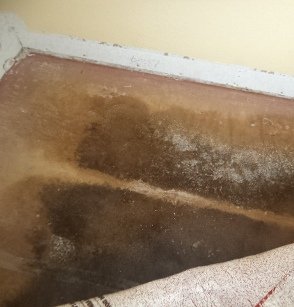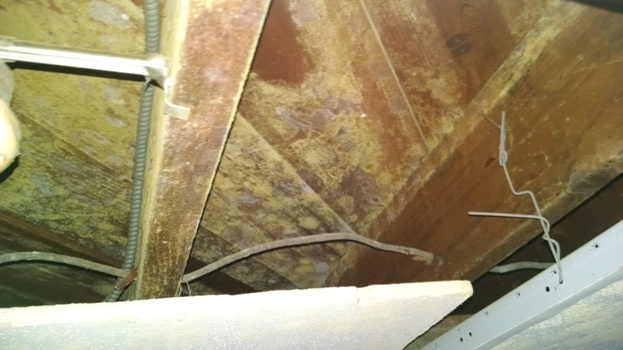Find a Mold Specialist Now
Click or Call, Toll-Free 24/7
Hidden mold: finding mold you can’t see
Hidden mold is a serious problem because mold can grow and spread unseen and you can end up with a huge mold problem before you know it. By the time you discover the mold, there may be significant damage to your home and the cost to remove the mold and repair all the damage can be great.
You can also suffer from mold-related health problems due to mold you can't even see, and if you don't know you've been exposed to mold, your doctor may find it difficult to make an accurate diagnosis. As long as mold remains in your home, medical treatment is unlikely to be very effective, so you may remain ill for quite some time before you figure out what's causing your symptoms. In some instances, exposure to unseen mold can lead to long-term or permanent health problems. You can read more about mold-related health problems.
 Mold Under Carpet
Mold Under CarpetHow Does Mold Hide?
Mold spores are very tiny, microscopic, in fact. That means they cannot be seen by the naked eye, only by a microscope. They are also very lightweight and easily drift in the air from place to place.
Since mold spores are so tiny, they can end up in all sorts of places, like under floorboards, inside walls, and in a home's heating, ventilation and air conditioning ducts. Most strains of mold grow rapidly and all it takes is a bit of moisture for a few mold spores to turn into a whole lot of mold. Mold can flourish in hidden places like these before finally making itself known.
How Do You Know if You Have Hidden Mold in Your Home?
If the whole point is that it's hidden, how do you even know it's there? Well, part of why it's such a big problem is that you may not know for a long time. However, you should suspect the possibility of hidden mold if:
- You smell a musty odor characteristic of mold (learn more about why mold causes that smell). Also note that not all mold smells musty. Mold can smell fruit like, floral, chocolate like, spicy, sour, oily or earth like.
- You have symptoms of mold-related illness, such as coughing, sneezing, runny nose, sore throat, headache, chronic sinus infections, asthma attacks, or other respiratory problems, but don't know what's causing your symptoms and your symptoms have not responded well to treatment (more about mold-related health issues).
- Your home has been flooded (note that the U.S. Environmental Protection Agency recommends calling in a professional to inspect your home and assist with the cleanup after a flood due to the risk of mold and other health hazards).
In addition, if you see some mold, you should inspect carefully for more mold, which may be hard to find. If there is mold on your carpet, for instance, there is a good chance there is also mold underneath the carpet. You should check (or have someone check for you).
While there are times you should suspect its presence, there are only two ways to know for sure if there is hidden mold in your home. You must either locate the mold and confirm its presence visually or have a mold test conducted which indicates the presence of mold.
Where Might You Find Hidden Mold?
 Mold Above Drop Ceiling
Mold Above Drop CeilingAnyplace you can imagine and probably some you wouldn't imagine. Mold can grow unseen in all sorts of places, including:
- in attics
- in crawlspaces
- under carpet
- under vinyl or linoleum flooring
- under floorboards
- above ceilings, like in the picture above
- under wallpaper
- inside walls
- in the insulation in your walls
- in your home's heating, ventilation and air conditioning system
If you're wondering how to go about finding mold in those places, well, it can be quite a challenge. Looking isn't always enough. Of course, you can pull up a carpet to check for mold beneath it. It's more difficult to look inside your walls or inside your homes HVAC system, though. Even if you try to look there, you might miss some mold growing there.
If You Need Help Finding Hidden Mold
If you’re not sure whether you have mold somewhere in your home, we suggest calling a professional mold tester. He or she will come to your home and conduct air tests, which will detect the presence of mold. Most mold testers are engineers, so they will also inspect your home to help find where the mold is, and determine what caused it to start growing. Follow this link to get a list of professional mold testers in your area.
Return From Hidden Mold To Home Page
Ref:
EPA
Privacy Policy Terms and Conditions Accessibility Do Not Sell My Information Disclaimer Contact Us




